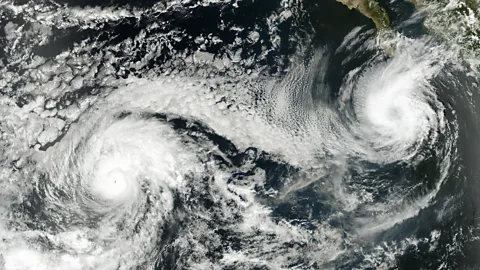Record ocean temperatures suggest the seas are warming faster than expected, and the impacts will be felt from polar ice shelves to coastal cities across the globe.
The world’s oceans are like a planet-sized battery: they absorb huge amounts of heat, which is then released slowly. So far, our oceans have soaked up over 90% of the heat trapped in the Earth’s atmosphere by rising greenhouse gas emissions. But recently, their rate of warming has been dramatic.
Every day since late March 2023, global ocean surface temperatures have set new records for the hottest temperature ever recorded on that date. On 47 of those days, temperatures have also surpassed previous highs by the largest margin seen in the satellite era, according to data from the European Union’s Copernicus Climate Change Service. (Read the analysis of the data in this article by the BBC News Climate and Science team.)
In February 2024, the world had breached 1.5C warming of surface air temperatures for a full year. But in some regions last year, ocean temperatures were similar to those expected if overall global warming of surface air temperatures reached 3C above pre-industrial levels – suggesting quicker ocean heating than expected.
This rapid heating raises a puzzle for scientists: why is recent ocean warming even greater than models suggest?
« The step-change in ocean temperatures over last year is huge, » says Hayley Fowler, professor of climate change impacts at Newcastle University in the UK. « The fact we can’t simulate these step-change increases and understand why it’s happening is terrifying. »

What is clear, however, is that ocean warming is already having damaging effects on people and ecosystems alike. In summer 2023, buoys off the coast of Florida recorded temperatures that were warmer than a hot tub. Coral reefs are currently undergoing their fourth planet-wide bleaching event, set to be the most extensive yet.
Other impacts are less talked about: from de-oxygenation of the deep seas, to more intense rain in the skies above. All indicate that record ocean temperatures are destabilising the planet.
What’s causing record ocean warming?
Two factors are primarily responsible for the past year’s record ocean heat, says Michael McPhaden, an oceanographer at the National Oceanic and Atmospheric Administration (Noaa) in the US. The first is the atmosphere’s ever-rising greenhouse gas concentrations.
The second was 2023’s major El Niño event, in which warmer-than-average surface waters in the tropical Pacific Ocean led to increased evaporation – and a vast transfer of heat to the atmosphere.
Other much weaker influences may also have played a role, says McPhaden. In early 2022, the Pacific volcano Tonga Hunga-Hunga Ha’apai erupted, releasing « unprecedented » amounts of water vapour, which trapped heat in the atmosphere. In 2020, a mandate by the International Maritime Organization also required commercial tankers to switch to low-sulphur fuel sources. This reduced the amount of sulphur dioxide emissions from global shipping. Sulphur dioxide is a precursor to atmospheric sulphates that reflect sunlight and contribute to bright trails of clouds behind ships, which reflect heat back out into space. Fewer of these bright trails could potentially lead to a small increase in global warming.
Even accounting for these factors, their inputs still don’t quite add up to the amount of ocean warming some areas are currently experiencing, says McPhaden. Parts of the northern Atlantic, for instance, are currently « extraordinarily » warm, for reasons still not well understood. The impact of warming the ocean could lead to new classes of heatwaves we’ve never seen before – Valerio Lucarini
Researchers are just beginning to investigate other factors. In one early study that has yet to be peer reviewed, Noaa oceanographer Boyin Huang attempts to explain the shortfall by pointing to another long-term (50-70 year) cycle of ocean heating and cooling in the higher latitudes.
While the causes of today’s record ocean heat are still to be understood, its impacts are already making themselves felt around the world.
Hurricanes ahead
One of the most notable effects is on precipitation and storm formation. If you have warmer sea surface temperatures, more moisture evaporates, explains Fowler. Global warming is heating the atmosphere at the same time, and warmer air is able to hold on to more moisture. So when it does rain, there is more of it. Plus, the effect is compounding: for every degree of warming, there’s the potential for another 7% increase in rainfall and moisture, Fowler says.
The speed at which storm systems intensified in 2023 also took weather forecasters by surprise. « Bomb cyclones« , for example, saw mid-latitude cyclones strengthen rapidly. Towards the Tropics, Hurricane Otis hit Acapulco on Mexico‘s Pacific coast in October 2023 after intensifying from a weak storm to a category five hurricane overnight, as did Hurricane Lee, which battered the Caribbean the month before.
« We think these are the result of warm ocean temperatures rapidly intensifying small storms into really big systems, » says Fowler. « But the jury is still out on the precise mechanisms. »

Particularly concerning in 2024 will be the potential for more active hurricanes. The recent El Niño system may soon switch to a La Niña phase. La Niña favours the formation of intense and frequent storms in the northern Atlantic off the coast of Africa by reducing wind shear. And with record warm sea surface temperatures transferring more energy to those storms as they then pass overhead, the resulting hurricane season is set to be one of the most active on record. (Learn more about how the most destructive hurricanes are born off the west coast of Africa.)
Furthermore, warmer oceans could also produce more extreme, « unicorn » type, heat events, says Valerio Lucarini, professor of applied mathematics at the University of Leicester in the UK. « The impact of warming the ocean could lead to new classes of heatwaves we’ve never seen before, » he says, since warmer oceans lead to greater evaporation and, in turn, higher humidity.
With human survival dependent on the heat index (when humidity and air temperature are considered together), increased ocean warming could lead to repeats of 2023’s record heatwaves on land.
Suffocating seas
Beneath the surface too, the impact of warming can be severe. From Australia to Tanzania, coral bleaching is becoming more frequent and extensive, notes Ana Queirós, a marine and climate change ecologist at Plymouth Marine Laboratory in the UK.
Unlike marine organisms such as fish, corals can’t move when the ocean around them experiences a heatwave, Queirós explains. With many areas of ocean now undergoing seabed heatwaves, the impact can be « terrible ».
Sign up to Future Earth
Sign up to the Future Earth newsletter to get essential climate news and hopeful developments in your inbox every Tuesday from Carl Nasman and the rest of the Future Earth team. This email is currently available to non-UK readers. In the UK? Sign up for newsletters here.
More generally, ocean warming is also depriving marine life of vital oxygen and nutrients. Oxygen is less soluble in warmer waters, and since surface water warms up before water lower down, it also becomes less dense, making it harder for water at the top and bottom of the ocean to mix. Without this mixing, nutrients deposited at or near the seafloor struggle to make it back to surface waters, where they are needed by microorganisms such as phytoplankton that form base of the foodweb. In turn, oxygen from surface waters cannot reach the deeper layers of the ocean.
The outcome, says Queirós, is more frequent seabed hypoxia (low oxygen) events, leading to die offs on the ocean floor. As well as the expansion of « oxygen minimum zones », in which seafloor areas are depleted in oxygen for long periods.
Rising seas
Coastlines also cannot escape the consequences of ocean warming. As ocean waters heat up and become less dense, they take up greater volumes of space, contributing to sea level rise. The warmer waters also cause sea ice melt in Antarctica and Greenland. Global average sea levels have risen an estimated 21-24cm (8-9 inches) in the past 140 years.It’s running hot and it’s running high – William Sweet
According to William Sweet, an oceanographer at Noaa, sea level rise is on pace to average a further 6-7in (15-18cm) by 2050. « Low-lying, densely populated areas are flooding more often than they used to – and it’s going to get worse, » he says.
Along the Gulf of Mexico and the east coast of the US, ocean levels are rising even faster than the average. « Right now, the rate of rise is beating all the models: it’s running hot and it’s running high, » says Sweet.
An Amoc slowdown?
Another tipping point risk associated with global heating is a slow-down and eventual collapse of the system of ocean currents known as the Atlantic meridional overturning circulation, or Amoc.
The Amoc circulation system links the southern Atlantic to the northern Atlantic and transports warm water from the tropical regions to the cooler north. As it travels, it cools and becomes more salty as some water evaporates. This cooler, saltier water is denser and eventually sinks to the bottom of the ocean and returns south. Lucarini notes that if you slow down this circulation, you reduce the amount of warm water transferred to the mid-high latitude regions of the Atlantic. This, in turn, produces a regional cooling effect in central western Europe.
The system is linked to the way that ocean warming changes precipitation and ice-melt, says Lucarini. Fresh rainwater doesn’t sink as well as denser sea water. So greater levels of precipitation in the northern Atlantic and increased ice melt from Greenland means less of it sinks and travels back south. The result is an overall weakening of the Amoc.
According to Lucarini, a weakened northwards circulation of warm water helps explain the fact that, despite an overall increase in ocean warming, there is currently a « cold blob » in a specific part of the northern Atlantic. Yet while there are signs that the current Amoc state is becoming unstable, how it might change, and how quickly, is still unclear. A recent paper by Lucarini and colleagues shows that there might be multiple, complex stages in between intense and weakened circulation.
« If Amoc slows down too much, it won’t necessarily recover – it might well jump to another state, with a very different climate regime, » he adds, citing a potential increase in everything from heatwaves and droughts to cold spells. The impacts could be especially strong in Europe and possibly Central Asia, as well as causing less rainfall in South America, which could push the Amazon Rainforest into a savannah.
« We’d be changing the rules of the game, » says Lucarini.



